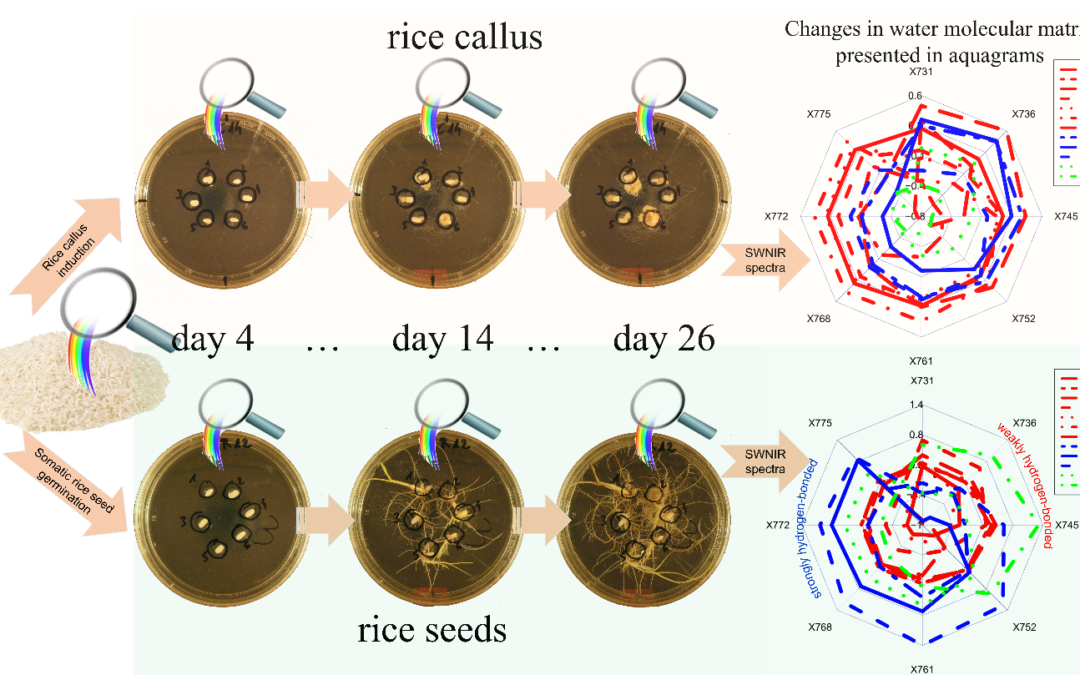
Near-infrared Spectroscopy
Near-infrared spectroscopic measurements performed in Japan and a special data analysis method provide new knowledge for a more detailed understanding of certain degenerative processes in plants. The study published by the staff of Kobe University, MATE and ADEXGO Kft. was published in the peer-reviewed journal Plants. The research team has played a significant role in the development and refinement of the aquaphotomics data analysis methodology, and a number of different applications have been reported in recent years.
Water spectral patterns reveals similarities and differences in rice germination and induced degenerated callus development
Zoltan Kovacs, Jelena Muncan, Nobuko Ohmido, George Bazar, Roumiana Tsenkova
In vivo monitoring of rice (Oryza sativa L.) seed germination and seedling growth under general conditions in closed Petri dishes containing agar base medium at room temperature (temperature = 24.5 ± 1 °C, relative humidity = 76 ± 7% (average ± standard deviation)), and induced degenerated callus formation with plant growth regulator, were performed using short-wavelength near-infrared spectroscopy and aquaphotomics over a period of 26 days. The results of spectral analysis suggest changes in water absorbances due to the production of common metabolites, as well as increases in biomass and the sizes of the samples. Quantitative models built to predict the day of the development provided better accuracy for rice seedlings growth compared to callus formation. Eight common water bands were identified as presenting prominent changes in the absorbance pattern. The water matrix of only rice seedlings showed three developmental stages: firstly expressing a predominantly weakly hydrogen-bonded state, then a more strongly hydrogen-bonded state, and then, again, a weakly hydrogen-bonded state at the end. In rice callus induction and proliferation, no similar change in water absorbance pattern was observed. The presented findings indicate the potential of aquaphotomics for the in vivo detection of degeneration in cell development.
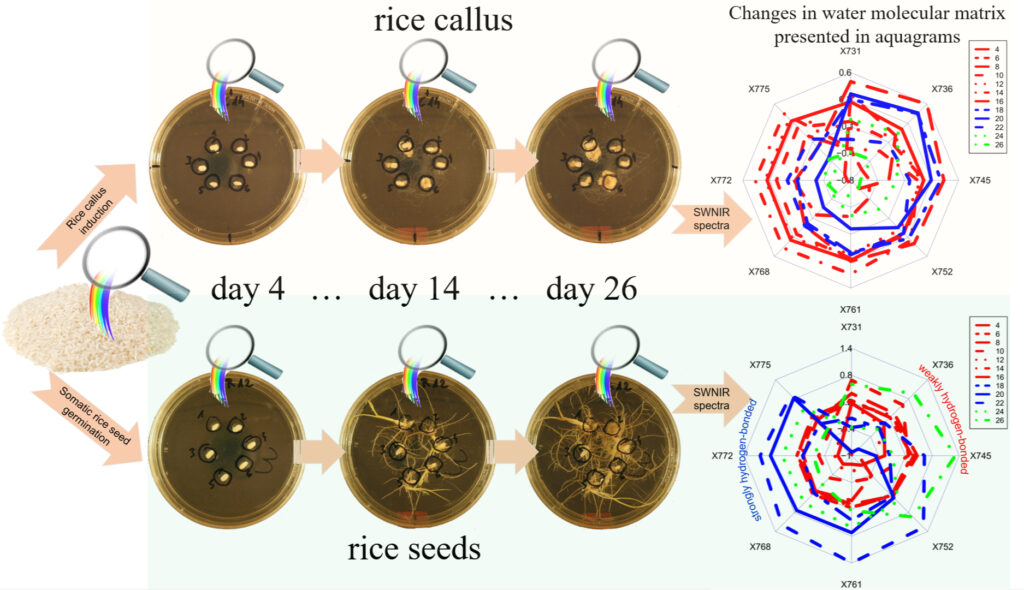
Access the full paper free of charge on the website of the journal:
» Water spectral patterns reveals similarities and differences in rice germination and induced degenerated callus development

Animal Nutrition and Physiology
Hungarian researchers were the first in the world to publish the results of digestive physiological studies based on electromyographic measurements performed on awake, growing pigs kept under farm conditions. The scientific publication presenting the results of the research conducted by the coworkers of ADEXGO Kft., Hungarian University of Agriculture and Life Sciences, MSB-MET Kft. and University of Szeged was published in PLoS ONE, a highly ranked multidisciplinary peer-reviewed scientific journal.
Non-invasive smooth muscle electromyography (SMEMG) as a novel monitoring technology of the gastrointestinal tract of awake, free-moving pigs—A pilot study
Katalin Nagy, Hedvig Fébel, George Bazar, György Grosz, Róbert Gáspár, Kálmán Ferenc Szűcs, Tamás Tóth
There are several mathematical models and measurements to determine the efficiency of the digestibility of different feedstuffs. However, there is lack of information regarding the direct methods or measurement techniques used to analyse the physical response of the different parts of the gastrointestinal tract (GIT) of growing pigs to different diets. Smooth muscle electromyography (SMEMG) is a non-invasive method for the measurement of gastrointestinal myoelectrical activity. In the present study, SMEMG methodology has been adapted from laboratory rats to pigs, and the effects of feedstuffs with control (CTR) or experimentally increased (EXP) amounts of fibre were investigated on gastrointestinal tract motility. Nine barrow pigs ((Danish Landrace × Danish Yorkshire) × Danish Duroc) were used (30 ± 3 kg), and their CTR and EXP feedstuffs contained 29 and 49 g/kg crude fibre (CF), respectively. Myoelectric activities of the stomach, ileum and caecum were detected in the awake pigs by a pair of electrodes. The recorded myoelectric signals were analysed with fast Fourier transformation (FFT), and the spectra were expressed in GIT section-specific cycles per minutes (cpm) values and the maximum power spectrum density (PsDmax). A significant increase (P < 0.001) was observed in the value of the PsDmax of the small intestine (20–25 cpm) as a consequence of the EXP diet. The PsDmax values of the stomach (3–5 cpm) and large intestine (1–3 cpm) did not show any significant change in pigs fed the EXP diet. As a direct and non-invasive method, SMEMG is suitable for the rapid evaluation of the effects of diets with different fibre contents on the GIT of non-anaesthetised, free-moving pigs.
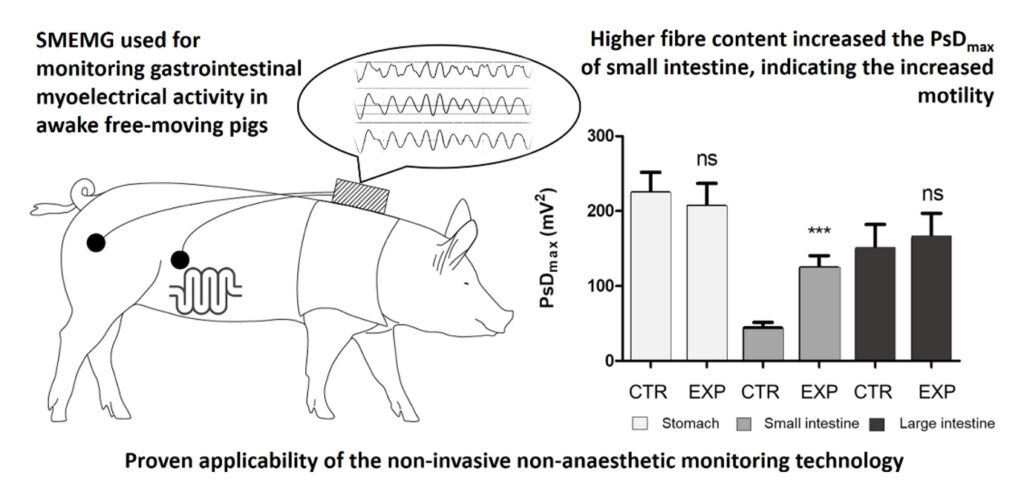
Access the full paper free of charge on the website of the journal:
» Non-invasive smooth muscle electromyography (SMEMG) as a novel monitoring technology of the gastrointestinal tract of awake, free-moving pigs – a pilot study
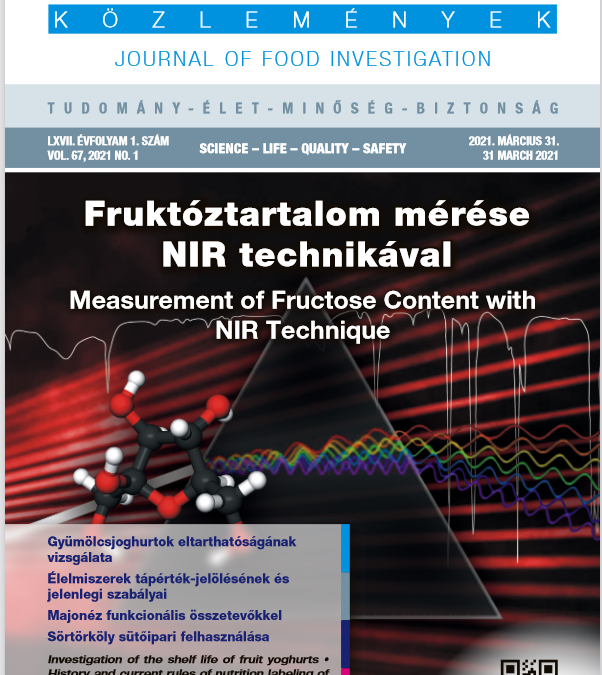
Near-infrared Spectroscopy
It is important to choose what and how much we consume. The physiological effects of the individual sugars are not the same, therefore it may be useful from a dietetic point of view to distinguish between different sugars, mono- and disaccharides, or to determine their amount present in different beverages and foods. In an article written with colleagues from MATE, we present the possibilities of near-infrared spectroscopy in the detection of fructose, which is referred to in several places as a sugar of public health risk, from pure aqueous solutions containing other sugars.
Near-infrared spectroscopy: rapid and effective tool for measuring fructose content
Haruna Gado Yakubu, Zoltán Kovács, Flóra Vitális, George Bázár
Since high fructose intake was found to be associated with increased health risks, it is important to raise awareness towards the amount of this widely used sugar within foods and beverages. The rapid and accurate detection and quantification of sugar types is not an easy task using conventional laboratory technologies. Near-infrared (NIR) spectroscopy has been proven to be a useful tool in this regard, and the present study highlights the applicability of this rapid correlative analytical technology in the measurement of fructose concentration against that of other sugars in aqueous solutions of sweeteners. The presented NIR calibrations are accurate for the relative measure of °Brix (R² = 0.84), and the direct measurement of the individual sugars (R² > 0.90) even in solutions with multiple sugars.

Access the full paper free of charge on the website of the journal:
» Near-infrared spectroscopy: rapid and effective tool for measuring fructose content
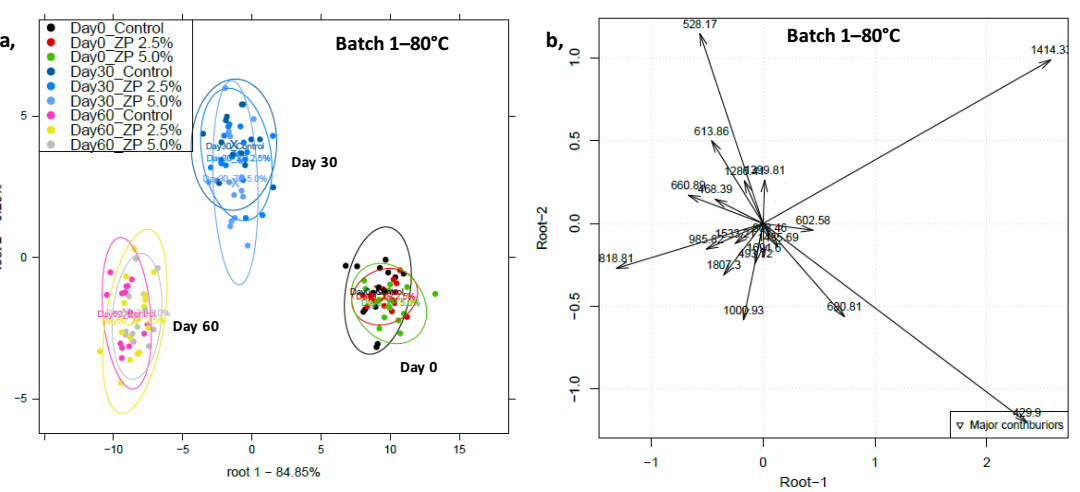
Animal Nutrition and Physiology, Instrumental Aroma Analysis
As a member of an international consortium, ADEXGO Kft. with the Hungarian University of Agriculture and Life Sciences, and the Romanian companies Avicola Lumina and Pharmacorp Innovation, participated in a three-year EUREKA project, the partial results of which were published in the journal Chemosensors with the co-authorship of our staff. Examination of egg quality by a number of methods revealed that the feed supplement based on the brewery by-product developed under the project did not significantly change the organoleptic characteristics of the eggs produced.
Evaluating the effect of a brewery by-product as feed supplementation on the quality of eggs by means of a human panel and e-tongue and e-nose analysis
Juan Pablo Aguinaga Bósquez, Zoltan Kovacs, Zoltán Gillay, György Bázár, Csaba Palkó, Hajnalka Hingyi, Éva Csavajda, Márta Üveges, Zsuzsanna Jókainé Szatura, Iuliana Diana Barbulescu, Mihaela Begea, Tamás Tóth
The objective of our research was to evaluate the possible alteration of the organoleptic properties of eggs produced by hens (Lohmann Brown-Classic) fed with diets containing different doses of an industrial by-product enriched with organic zinc (Zincoppyeast, ZP): Control 0%, ZP 2.5%, and ZP 5.0%. Eggs were collected after 30 days (batch 1) and 60 days (batch 2) of feeding with the experimental diets and subjected to chemical, microbiological, human sensory, e-nose, and e-tongue analyses. There was no significant difference among the microbiological status of eggs of the three groups, but there were significant differences (p < 0.05) in the fat (9.5% vs. 9.3%) and protein contents (12.7% vs. 13.4%) of the Control and ZP 5.0% groups, respectively. Human sensory analysis showed no clear change in the organoleptic characteristics of the eggs. Using linear discriminant analysis (LDA), the e-tongue could recognize the three groups of eggs in batch 1 and batch 2 with 95.9% and 100% accuracy and had a prediction accuracy of 64.8% and 56.2%, respectively. When the eggs were incubating at 50 °C or 80 °C before the e-nose analysis, the groups of eggs could be recognized with 98.0% and 82.7% accuracy, and predicted with 68.5% and 62.2% accuracy, respectively, using principal component analysis-based discriminant analysis (PCA–DA). The aroma compounds and respective sensory descriptors showing changes among the different groups of eggs (batch, storage, and feeding) were identified based on the e-nose analysis. The supplementation of laying hens’ feed with the investigated industrial by-product can be applied without any substantial effect on egg quality, which can, however, be detected with advanced analytical methods.

Access the full paper free of charge on the website of the journal:
» Evaluating the effect of a brewery by-product as feed supplementation on the quality of eggs by means of a human panel and e-tongue and e-nose analysis
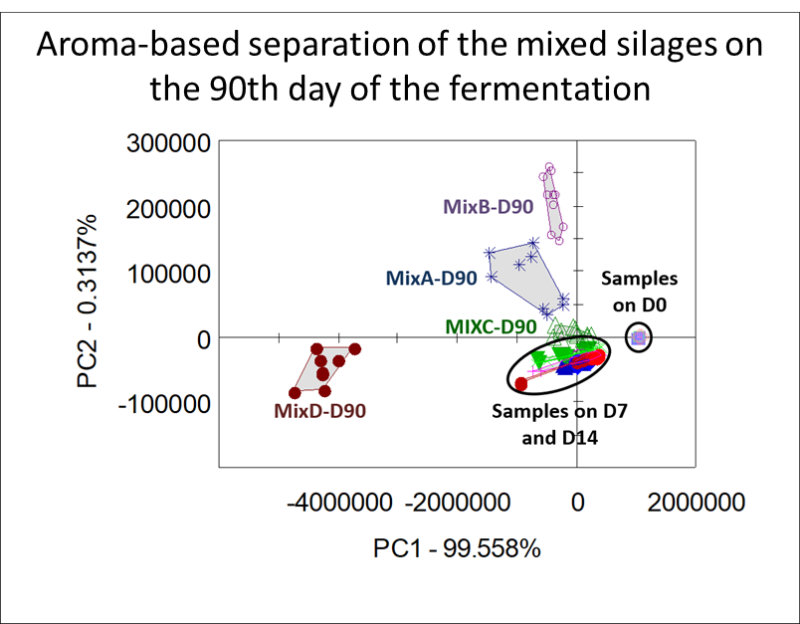
Animal Nutrition and Physiology, Instrumental Aroma Analysis
An objective rapid analysis of fermented silages was developed in the Correltech® Laboratory of ADEXGO Kft., mainly based on the aromaprofile analysis. Instrumental odor analysis, which can be performed under field conditions, is still a long-term goal, but the results presented with the coworkers of the Hungarian University of Agriculture and Life Sciences and Livestock Performance Testing Ltd. are encouraging and justify further thorough research in the field.
Aroma profile, microbial and chemical quality of ensiled green forages mixtures of winter cereals and Italian ryegrass
Alemayehu Worku, Tamás Tóth, Szilvia Orosz, Hedvig Fébel, László Kacsala, Balázs Húth, Richárd Hoffmann, Haruna Gado Yakubu, George Bazar, Róbert Tóthi
The objective of this study was to evaluate the aroma profile, microbial and chemical quality of winter cereals (triticale, oats, barley and wheat) and Italian ryegrass (Lolium multiflorum Lam., IRG) plus winter cereal mixture silages detected with an electronic nose. Four commercial mixtures (mixture A (40% of two cultivars of winter triticale + 30% of two cultivars of winter oats + 20% of winter barley + 10% of winter wheat), mixture B (50% of two cultivars of winter triticale + 40% of winter barley + 10% of winter wheat), mixture C (55% of three types of Italian ryegrass + 45% of two cultivars of winter oat), mixture D (40% of three types of Italian ryegrass + 30% of two cultivars of winter oat + 15% of two cultivars of winter triticale + 10% of winter barley + 5% of winter wheat)) were harvested, wilted and ensiled in laboratory-scale silos (n = 80) without additives. Both the principal component analysis (PCA) score plot for aroma profile and linear discriminant analysis (LDA) classification revealed that mixture D had different aroma profile than other mixture silages. The difference was caused by the presence of high ethanol and lactic acid (LA) in mixture D. Ethyl esters such as ethyl 3-methyl pentanoate, 2-methylpropanal, ethyl acetate, isoamyl acetate and ethyl-3-methylthiopropanoate were found at different retention indices in mixture D silage. The low LA and higher mold and yeast count in mixture C silage caused off odour due to the presence of 3-methylbutanoic acid, a simple alcohol with unpleasant camphor-like odor. At the end of 90 days fermentation winter cereal mixture silages (mixture A and B) had similar aroma pattern, and mixture C was also similar to winter cereal silages. However, mixture D had different aromatic pattern than other ensiled mixtures. Mixture C had higher (p < 0.05) mold and yeast (Log10 CFU (colony forming unit)/g) counts compared to mixture B. Mixture B and C had higher acetic acid (AA) content than mixture A and D. The lactic acid (LA) content was higher for mixture B than mixture C. In general, the electronic nose (EN) results revealed that the Italian ryegrass and winter cereal mixtures (mixture D) had better aroma profile as compared to winter cereal mixtures (mixture A and B). However, the cereal mixtures (mixture A and B) had better aroma quality than mixture C silage. Otherwise, the EN technology is suitable in finding off odor compounds of ensiled forages.
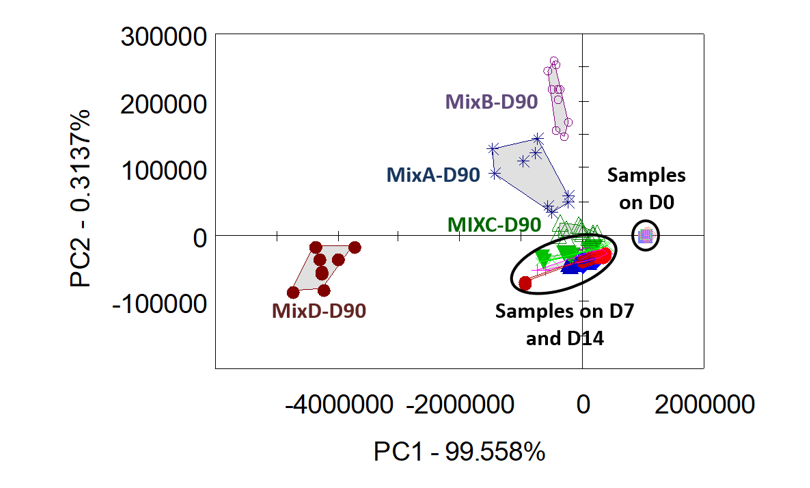
Aroma-based separation of the mixed silages on the 90th day of the fermentation
Access the full paper free of charge on the website of the journal:
» Fermentation quality and aroma profile of winter cereals and Italian ryegrass plus winter cereal mixture silages
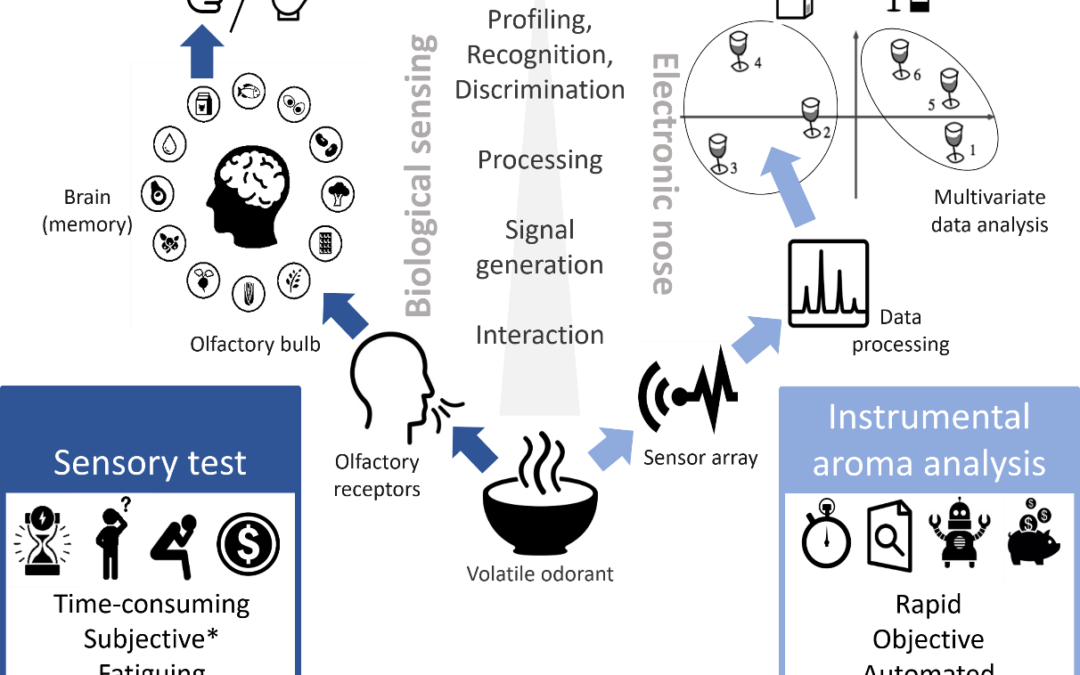
Animal Nutrition and Physiology, Instrumental Aroma Analysis
With the participation of the staff of ADEXGO Kft., Széchenyi University and MATE, a wide-ranging literature review was again published in the prestigious international scientific journal Critical Reviews in Food Science and Nutrition. This time, the review paper presents the technical background of instrumental aroma analysis and discusses in detail its applications in the evaluation of milk and dairy products.
Trends in artificial aroma sensing by means of electronic nose technologies to advance dairy production – a review
Haruna Gado Yakubu, Zoltan Kovacs, Tamas Toth, George Bazar
Controversies surrounding the name and how the electronics nose (e-nose) works have been at the center stage since the advent of the technology. Notwithstanding the controversies, the technology has gained popularity in the sensory analysis of dairy foods, because of its rapid results delivery on product aroma profile or pattern, which can be used to assess quality. This review critically evaluated the advances made in the application of the e-nose or artificial sensory system in the dairy industry, focusing on the evaluation of milk, yoghurt and cheese properties, and the trends and prospects of the technology. Most of the e-nose devices applied in the available scientific publications used sensors such as metal oxide semiconductor sensors (MOS), metal-oxide-semiconductor field-effect transistor (MOSFET), conducting polymers composites and quartz microbalance (QMB), and flame ionization detector FID, in a recent study. Though known for aroma sensing, the technology has been applied to evaluate the shelf life or microbial spoilage and to discriminate dairy products based on the volatile profile composition, as determined by the sensors. In most cases, the limitation of the technology is the inability of it to provide information on the nature of constituting compounds, except in gas chromatography and mass spectrometry-based e-nose systems.
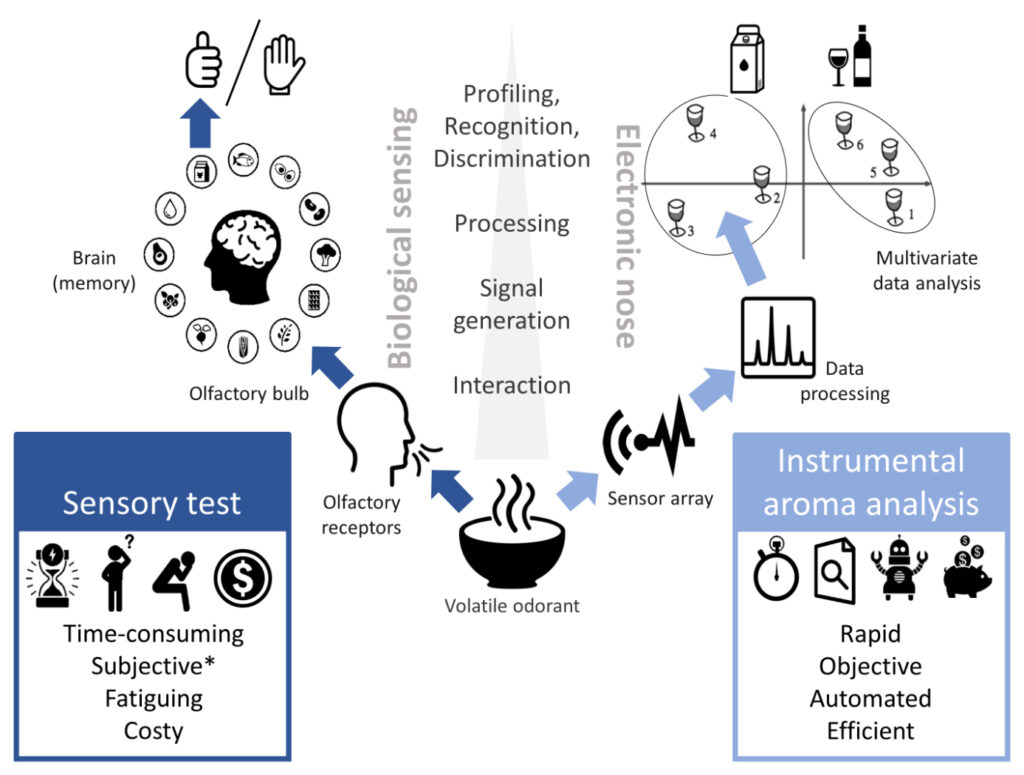
Purchase the full paper on the website of the journal or request a copy from the authors:
» Trends in artificial aroma sensing by means of electronic nose technologies to advance dairy production – a review
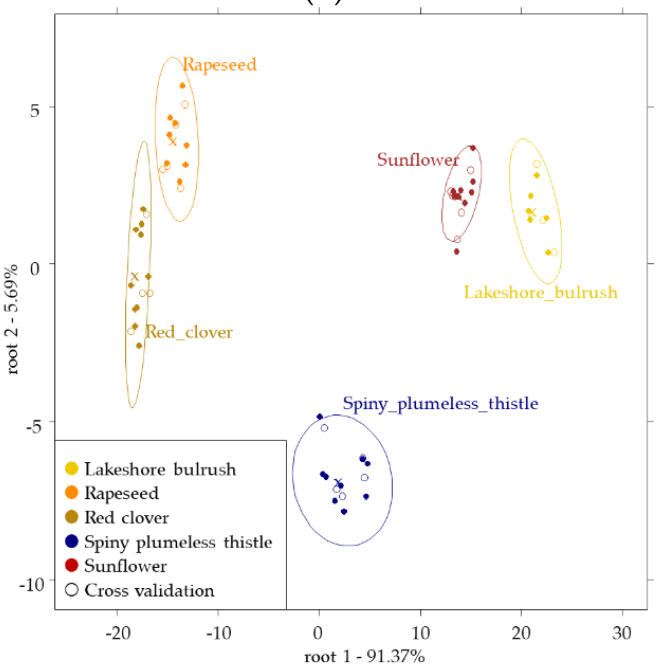
Instrumental Aroma Analysis
A complex study by scientists of MATE presents a classification approach of bee pollen by means of different methodologies. Tests for volatile components were performed in the Correltech® laboratory of ADEXGO Kft. Based on the results, another area of application emerges where the electronic nose as a fast and objective analytical methodology has significant potential.
Classification of bee pollen and prediction of sensory and colorimetric attributes — a sensometric fusion approach by e-nose, e-tongue and NIR
László Sipos, Rita Végh, Zsanett Bodor, John-Lewis Z. Zaukuu, Géza Hitka, George Bázár, Zoltan Kovacs
The chemical composition of bee pollens differs greatly and depends primarily on the botanical origin of the product. Therefore, it is a crucially important task to discriminate pollens of different plant species. In our work, we aim to determine the applicability of microscopic pollen analysis, spectral colour measurement, sensory, NIR spectroscopy, e-nose and e-tongue methods for the classification of bee pollen of five different botanical origins. Chemometric methods (PCA, LDA) were used to classify bee pollen loads by analysing the statistical pattern of the samples and to determine the independent and combined effects of the above-mentioned methods. The results of the microscopic analysis identified 100% of sunflower, red clover, rapeseed and two polyfloral pollens mainly containing lakeshore bulrush and spiny plumeless thistle. The colour profiles of the samples were different for the five different samples. E-nose and NIR provided 100% classification accuracy, while e-tongue > 94% classification accuracy for the botanical origin identification using LDA. Partial least square regression (PLS) results built to regress on the sensory and spectral colour attributes using the fused data of NIR spectroscopy, e-nose and e-tongue showed higher than 0.8 R2 during the validation except for one attribute, which was much higher compared to the independent models built for instruments.

Access the full paper free of charge on the website of the journal:
» Bee pollen classification by means of microscopic pollen analysis, spectral colour measurement, sensory, NIR spectroscopy, e-nose and e-tongue methods – sensometric fusion approach
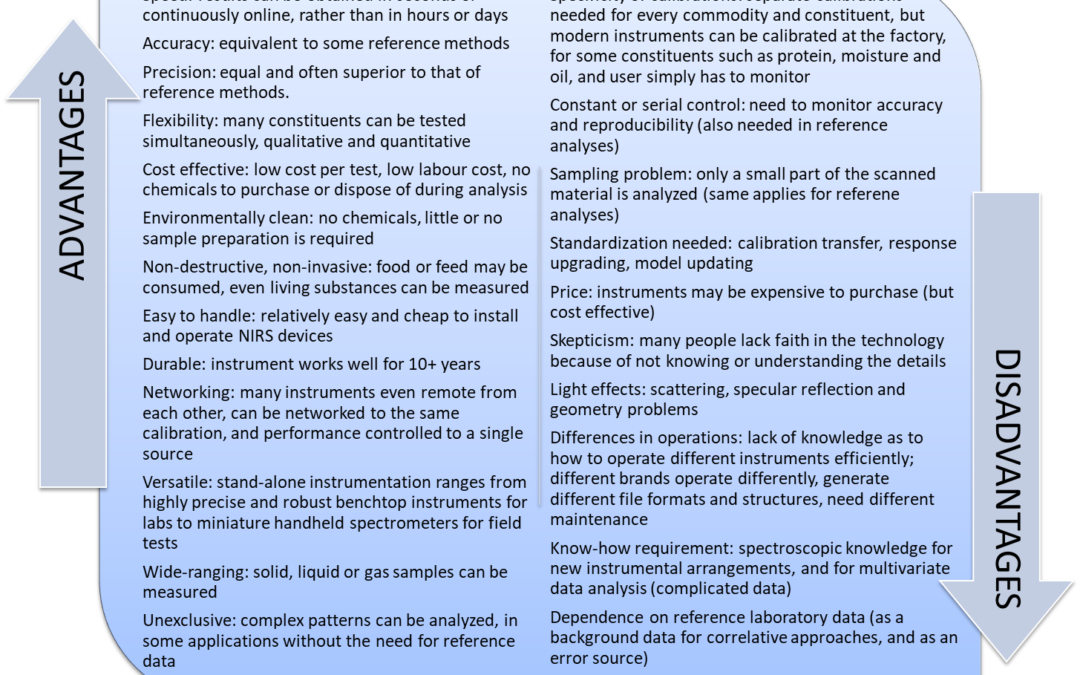
Animal Nutrition and Physiology, Near-infrared Spectroscopy
Published by the scientists of ADEXGO Kft., Széchenyi University and MATE, an extremely thorough literature review is now available in the prestigious international scientific journal Critical Reviews in Food Science and Nutrition. In addition to the technical background of near-infrared spectroscopy, the review paper discusses in detail its applications in the entire product chain, from the feeding of dairy cattle to the testing of raw milk and dairy products.
The recent advances of near-infrared spectroscopy in dairy production – a review
Haruna Gado Yakubu, Zoltan Kovacs, Tamas Toth, George Bazar
One of the major issues confronting the dairy industry is the efficient evaluation of the quality of feed, milk and dairy products. Over the years, the use of rapid analytical methods in the dairy industry has become imperative. This is because of the documented evidence of adulteration, microbial contamination and the influence of feed on the quality of milk and dairy products. Because of the delays involved in the use of wet chemistry methods during the evaluation of these products, rapid analytical techniques such as near-infrared spectroscopy (NIRS) has gained prominence and proven to be an efficient tool, providing instant results. The technique is rapid, nondestructive, precise and cost-effective, compared with other laboratory techniques. Handheld NIRS devices are easily used on the farm to perform quality control measures on an incoming feed from suppliers, during feed preparation, milking and processing of cheese, butter and yoghurt. This ensures that quality feed, milk and other dairy products are obtained. This review considers research articles published in reputable journals which explored the possible application of NIRS in the dairy industry. Emphasis was on what quality parameters were easily measured with NIRS, and the limitations in some instances.
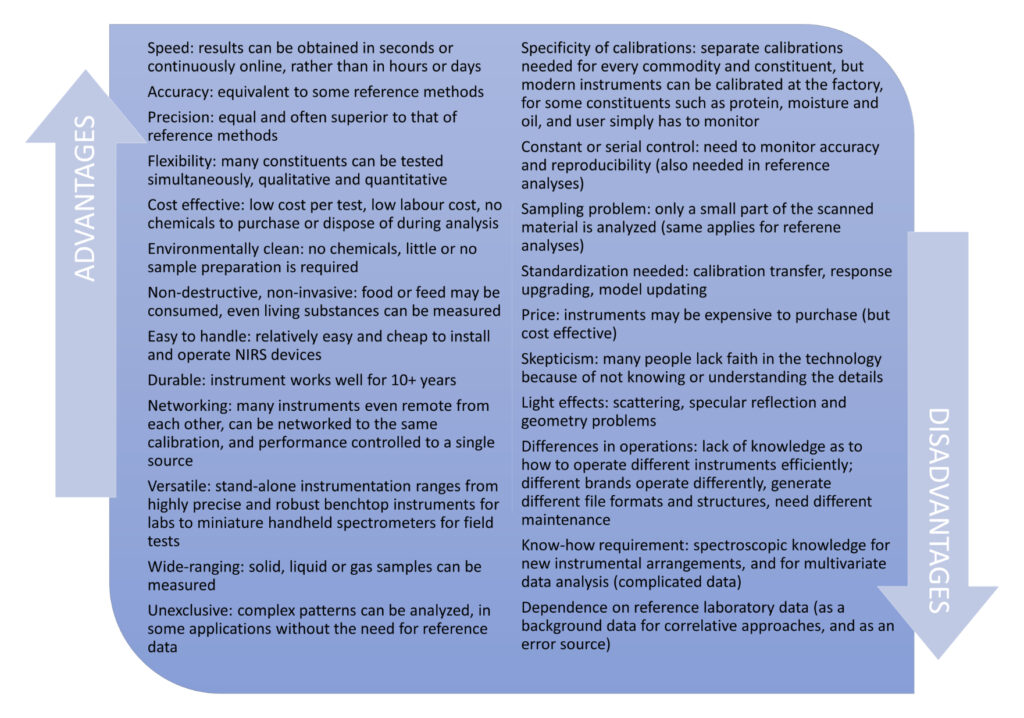
Purchase the full paper on the website of the journal or request a copy from the authors:
» The recent advances of near-infrared spectroscopy in dairy production – a review

Instrumental Aroma Analysis
Based on the aroma tests performed in the Correltech® laboratory of ADEXGO Kft., scientists of MATE performed the classification of dairy products fermented with Lactobacillus strains showing different probiotic potentials. The study raises the possibility that the electronic nose can be used in the selection of probiotic cultures as well as in the monitoring of the fermentation processes.
Electronic nose for monitoring odor changes of lactobacillus species during milk fermentation and rapid selection of probiotic candidates
Zoltan Kovacs, Zsanett Bodor, John-Lewis Zinia Zaukuu, Timea Kaszab, George Bazar, Tamás Tóth, Csilla Mohácsi-Farkas
Probiotic bacteria have been associated with a unique production of aroma compounds in fermented foods but rapid methods for discriminating between foods containing probiotic, moderately probiotic, or non-probiotic bacteria remain aloof. An electronic nose (e-nose) is a high-sensitivity instrument capable of non-invasive volatile measurements of foods. In our study, we applied the e-nose to differentiate probiotic, moderately probiotic, and non-probiotic Lactobacillus bacteria strains at different fermentation time points (0th, 4th, and 11th) of milk fermentation. The pH of the changing milk medium was monitored with their corresponding increase in microbial cell counts. An e-nose with two gas chromatographic columns was used to develop classification models for the different bacteria groups and time points and to monitor the formation of the aromatic compounds during the fermentation process. Results of the e-nose showed good classification accuracy of the different bacteria groups at the 0th (74.44% for column 1 and 82.78% for column 2), the 4th (89.44% for column 1 and 92.22% for column 2), and the 11th (81.67% for column 1 and 81.67% for column 2) hour of fermentation. The loading vectors of the classification models showed the importance of some specific aroma compounds formed during the fermentation. Results show that aroma monitoring of the fermentation process with the e-nose is a promising and reliable analytical method for the rapid classification of bacteria strains according to their probiotic activity and for the monitoring of aroma changes during the fermentation process.

Access the full paper free of charge on the website of the journal:
» Electronic nose for monitoring odor changes of Lactobacillus species during milk fermentation and rapid selection of probiotic candidates
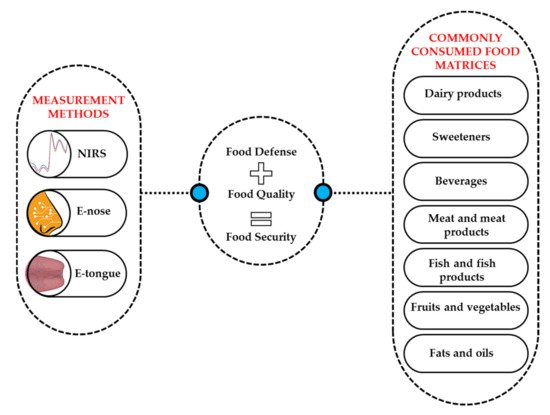
Instrumental Aroma Analysis, Near-infrared Spectroscopy
Together with scientists of MATE, our colleague was the guest editor of the special issue of the scientific journal Sensors, entitled “Breakthroughs and Challenges in Food Quality Assessment Using Advanced Rapid Techniques: Electronic Tongue, Electronic Nose, and Near-Infrared Spectroscopy”, published in November 2020. The special issue opens with an article on history of development of these three correlative techniques based on literature data, and also discusses in detail the attempts to apply them in food research over the past decades.
Historical evolution and food control achievements of near infrared spectroscopy, electronic nose, and electronic tongue — critical overview
Balkis Aouadi, John-Lewis Zinia Zaukuu, Flora Vitális, Zsanett Bodor, Orsolya Fehér, Zoltan Gillay, George Bazar, Zoltan Kovacs
Amid today’s stringent regulations and rising consumer awareness, failing to meet quality standards often results in health and financial compromises. In the lookout for solutions, the food industry has seen a surge in high-performing systems all along the production chain. By virtue of their wide-range designs, speed, and real-time data processing, the electronic tongue (E-tongue), electronic nose (E-nose), and near infrared (NIR) spectroscopy have been at the forefront of quality control technologies. The instruments have been used to fingerprint food properties and to control food production from farm-to-fork. Coupled with advanced chemometric tools, these high-throughput yet cost-effective tools have shifted the focus away from lengthy and laborious conventional methods. This special issue paper focuses on the historical overview of the instruments and their role in food quality measurements based on defined food matrices from the Codex General Standards. The instruments have been used to detect, classify, and predict adulteration of dairy products, sweeteners, beverages, fruits and vegetables, meat, and fish products. Multiple physico-chemical and sensory parameters of these foods have also been predicted with the instruments in combination with chemometrics. Their inherent potential for speedy, affordable, and reliable measurements makes them a perfect choice for food control. The high sensitivity of the instruments can sometimes be generally challenging due to the influence of environmental conditions, but mathematical correction techniques exist to combat these challenges.

Access the full paper free of charge on the website of the journal:
» Historical evolution and food control achievements of near infrared spectroscopy, electronic nose and electronic tongue – critical overview




















